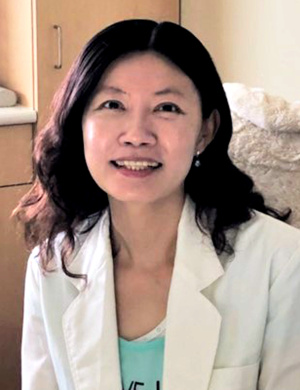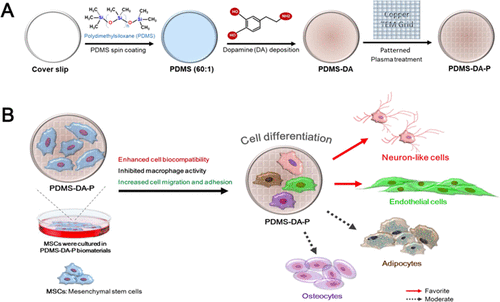| 作者/單位: | 洪慧珊/生物醫學研究所 |
| 期刊名稱: | ACS APPLIED MATERIALS & INTERFACES |
| IF值: | 8.758 |
| 領域排名: | MATERIALS SCIENCE, MULTIDISCIPLINARY (33/314) 10.5% |
| 文章摘要: |
Controlling the behavior of mesenchymal stem cells (MSCs) through topographic patterns is an effective approach for stem cell studies. We, herein, reported a facile method to create a dopamine (DA) pattern on poly(dimethylsiloxane) (PDMS). The topography of micropatterned DA was produced on PDMS after plasma treatment. The grid-topographic-patterned surface of PDMS-DA (PDMS-DA-P) was measured for adhesion force and Young's modulus by atomic force microscopy. The surface of PDMS-DA-P demonstrated less stiff and more elastic characteristics compared to either nonpatterned PDMS-DA or PDMS. The PDMS-DA-P evidently enhanced the differentiation of MSCs into various tissue cells, including nerve, vessel, bone, and fat. We further designed comprehensive experiments to investigate adhesion, proliferation, and differentiation of MSCs in response to PDMS-DA-P and showed that the DA-patterned surface had good biocompatibility and did not activate macrophages or platelets in vitro and had low foreign body reaction in vivo. Besides, it protected MSCs from apoptosis as well as excessive reactive oxygen species (ROS) generation. Particularly, the patterned surface enhanced the differentiation capacity of MSCs toward neural and endothelial cells. The stromal cell-derived factor-1α/CXantiCR4 pathway may be involved in mediating the self-recruitment and promoting the differentiation of MSCs. These findings support the potential application of PDMS-DA-P in either cell treatment or tissue repair. |
發表者簡介
 |
| 單位:醫學院生物醫學研究所 副教授 |
|
研究專長:
|



